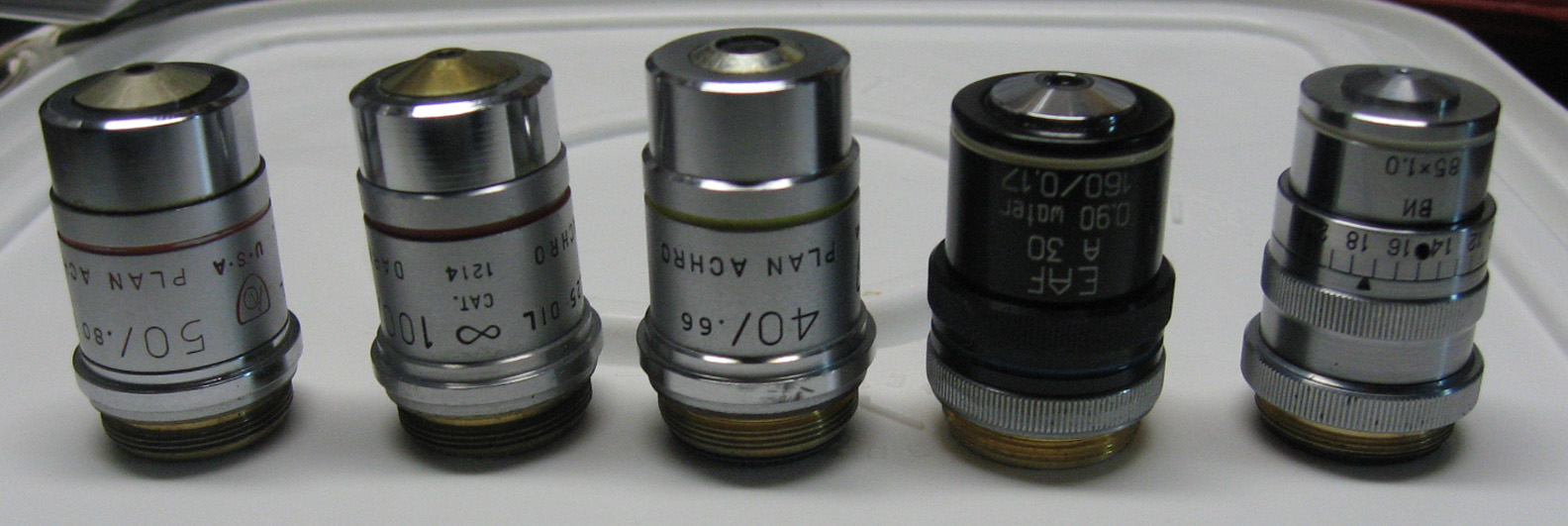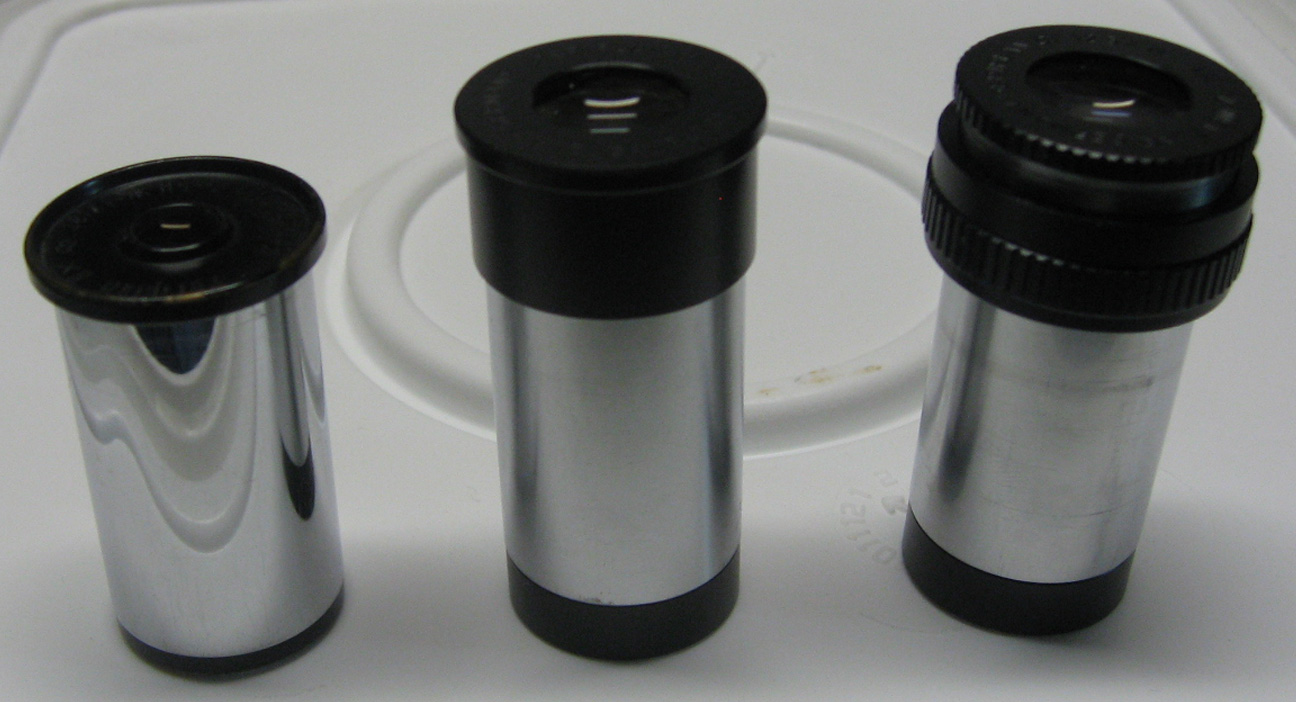 Apparent
Sharpness from Objectives and Eyepieces by
Steve Neeley, Utah, USA
Apparent
Sharpness from Objectives and Eyepieces by
Steve Neeley, Utah, USA Apparent
Sharpness from Objectives and Eyepieces by
Steve Neeley, Utah, USA
Apparent
Sharpness from Objectives and Eyepieces by
Steve Neeley, Utah, USA
While reading Dave Jackson’s book ‘Digital Photo-Microscopy’ (available on Lulu.com for $17.95 USD), I realized he’d answered a question I had had in the back of my mind for some while, and at the same time, cleared up an observational mystery that many of us must have stumbled upon:
The question: How do you predict ‘sharpness of image’ for an objective?
The mystery:
Why does using a lower power eyepiece seem to improve image
sharpness?

Some fine objectives. From left to right: An AO 50x/.80, an AO 100x/1.25, and AO 40x/.66, a LOMO 30x/.90, and a LOMO 85x/1.00. Which promises to provide a sharper image (all things being equal)?
I. Comparing Objectives for apparent sharpness
In Appendix 1, note 1, Dave derives an Images Sharpness Index (ISI – expressed as a percent) for an objective by:
Relying on the ‘Sparrow Limit’ (similar too, but more technically sound and less subjective, than the commonly talked about ‘Rayleigh Criterion’)
Using a standard value for the 20-20 vision resolution of the human eye – 1 arc minute
Assuming a10x eyepiece.
The resulting index (i.e. ISI) is given by:
ISI = 2650 * (objective N.A.) / (objective magnification)
(Note: if the N.A. of the condenser is less than the objective N.A., then the ‘effective’ N.A. will be: (objective N.A. + condenser N.A.) / 2)
For instance, a 40x/0.65 objective yields . . . 2650 * 0.65 / 40 = 43% ISI.
A practical example: So, given 100x/1.40, 63x/0.95, and 40x/0.65 objectives, which will yield the sharpest apparent image to the eye?
|
Objective |
ISI rating |
|
100x/1.40 |
37% |
|
63x/0.95 |
40% |
|
40x/0.65 |
43% |
Maybe surprisingly, the 40x/0.65 lens will give the sharpest apparent image. In comparison, the 100x/1.40 lens will fare even worse if its 1.40 N.A. is not reachable (you’d have to have a 1.40 N.A. condenser oiled to the slide . . . otherwise, the effective N.A. may be more like (1 + 1.4) / 2 = 1.2, which would then yield a 32% ISI).
What about those
objectives pictured in the line-up above?
|
Objective |
ISI rating |
|
AO 50x/.80 |
42% |
|
AO 100x/1.25 |
33% |
|
AO 40x/.66 |
44% |
|
LOMO 30x/.90 |
80% |
|
LOMO 85x/1.00 |
31% |
The LOMO 30x/.90 (Water Immersion) wins hands-down – which pretty much parallels the reputation this lens has for tack-sharp images. Notice though how even the lowly AO 40x/.66 nudges out (just barely) the somewhat specialized AO 50x/.80 ‘pathology’ lens.
So, all things being equal (e.g. an Fluorite or APO compared with an Achromat would be expected to be sharper on many specimens because of the chromatic correction) it is often better to use a lower power objective for visual sharpness as long as its N.A. is acceptable for the specimen and your intended use.
Those last ‘weasel words’ are important because ‘apparent sharpness’ to the eye is not the same as resolution. Clearly the 100x/1.40 objective is capable of better resolution than the 40x/0.65! But in actual use – as you well know – there is this ‘battle’ between:
(A) Our quest for higher resolution (i.e. N.A.),
(B) Ease-of-use (e.g. do you really want to oil that objective and condenser to the slide?) and
(C) Sharpness and contrast . . . the perception of visual detail (i.e. to the eye, sharpness, the feeling of perceiving greater detail, and contrast, are important)
So, bottom line, choose the objective with the highest ISI rating if it will do the job (i.e. the N.A. is sufficient for your purpose) because you’ll like the image better.
Dave gives a table (admittedly subjective) of ISI guidelines:
|
Sharpness |
ISI Rating |
|
Very High |
> 90% |
|
High |
65 – 90 % |
|
Medium |
40 -65 % |
|
Acceptable |
30- 40% |
|
Low |
< 30% |
. . along with the admonition to try to stay in at least the Medium range, if not the upper-Medium. Dave notes that for any ISI rating of < 50%, using a lower-power eyepiece helps a lot. Which brings us to the observational mystery . . . .
II. A Lower Power Eyepiece Improves ‘Apparent’ Image Sharpness
Remember in the above that we assumed a 10x eyepiece? If your ISI rating is 50% or below, you can dramatically increase the ISI rating, and hence the apparent sharpness, by using a lower power eyepiece.
Dave’s formula: New ISI rating = Original ISI rating * 10 / new eyepiece power
So for instance, let’s say you have a 40x/0.55 objective with a 10x eyepiece. The ISI rating for that combination is: 2650 * 0.55 / 40 = 36%. That puts it in the acceptable range but nothing stellar. You can boost the apparent sharpness dramatically if you have an 8x eyepiece that will work with that objective.
New ISI rating = 36% * 10 / 8 = 45%

Above, from left to right: An 8x Leitz Periplan, a 10x Leitz GF Periplan, and a 12.5x Leitz GF Periplan. I have to admit that the aging, venerable 8x on the left often provides a sharper image.
So, bottom line, using a lower power eyepiece will always boost the apparent sharpness of the image perceived by the eye . . . sometimes dramatically.
I’ve heard people say things like: “These 8x eyepieces are my favorites. They just seem to yield a better image than my 10x, or 12.5x, standards.” Such a statement is perfectly understandable now – they actually do yield a more contrasty, sharp image to the human eye.
In conclusion, let’s go back for a moment to the ‘sharpness contest’ at the beginning between the pictured objectives and let’s see what we can conclude:
(A) The AO 50x/.80 and 40x/.66 are in the ‘Medium’ range of Dave’s suggested guidelines. These objectives might benefit from a good 8x eyepiece.
(B) The LOMO 30x/.90 needs no help. Using a lower power eyepiece is just not needed at all (in fact, its image won’t suffer appreciably from higher power eyepieces either).
(C) But the AO 100x/1.25 and LOMO 85x/1.0 would benefit from a lower power eyepiece. Traditionally, I believe, this is just where these eyepieces shine – boosting the sharpness of higher power objectives.
-- The End --
All comments to the author Steve Neeley are welcome.
Note: If you have an AO microscope, Steve has a website that offers, freely, a ‘library’ of documentation for these scopes. See: http://www.xmission.com/~psneeley/Personal/Microscope.htm
Published in the December 2009 edition of Micscape.
Please report any Web problems or offer general comments to the Micscape Editor .
Micscape is the on-line monthly magazine of the Microscopy UK web site at Microscopy-UK
©
Onview.net Ltd, Microscopy-UK, and all contributors 1995
onwards. All rights reserved.
Main site is at
www.microscopy-uk.org.uk
with full mirror
at
www.microscopy-uk.net
.